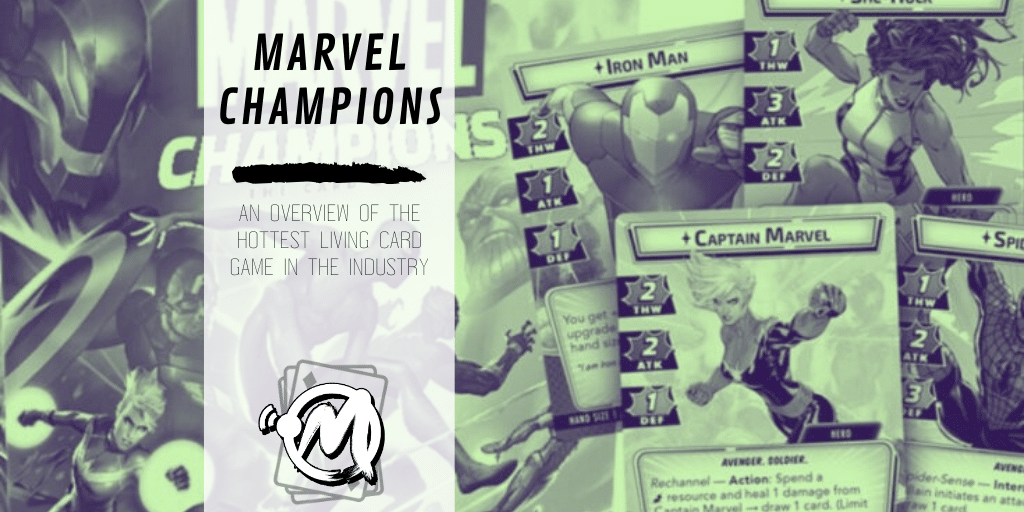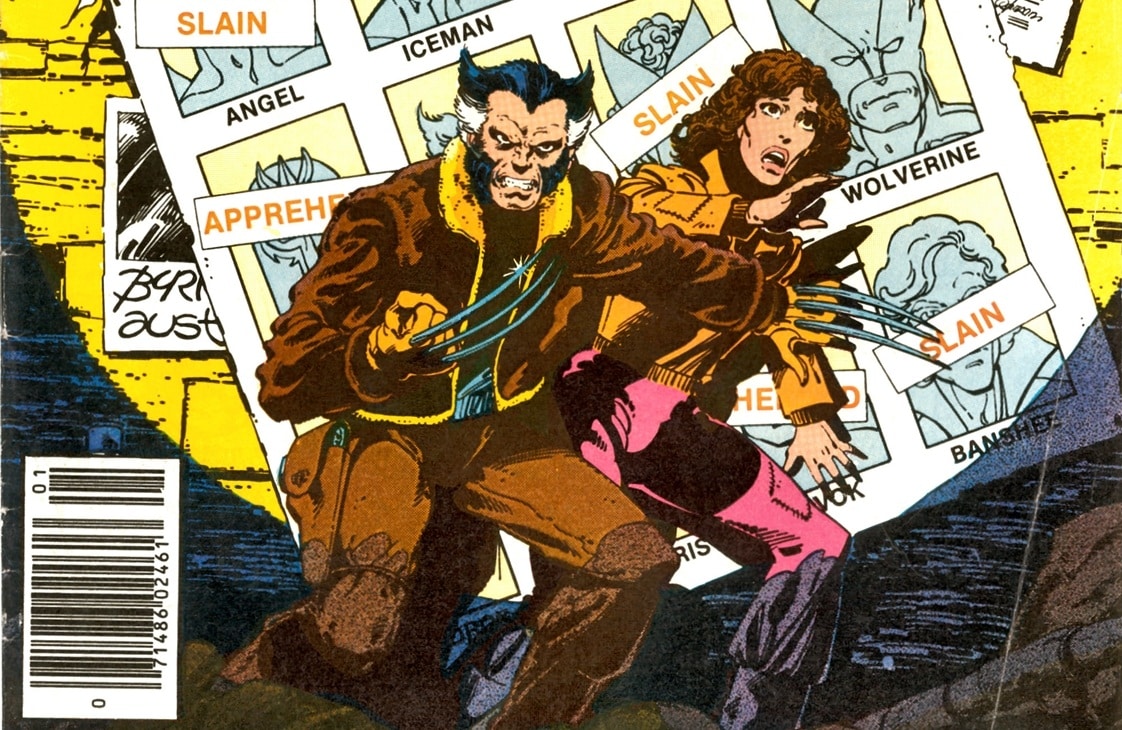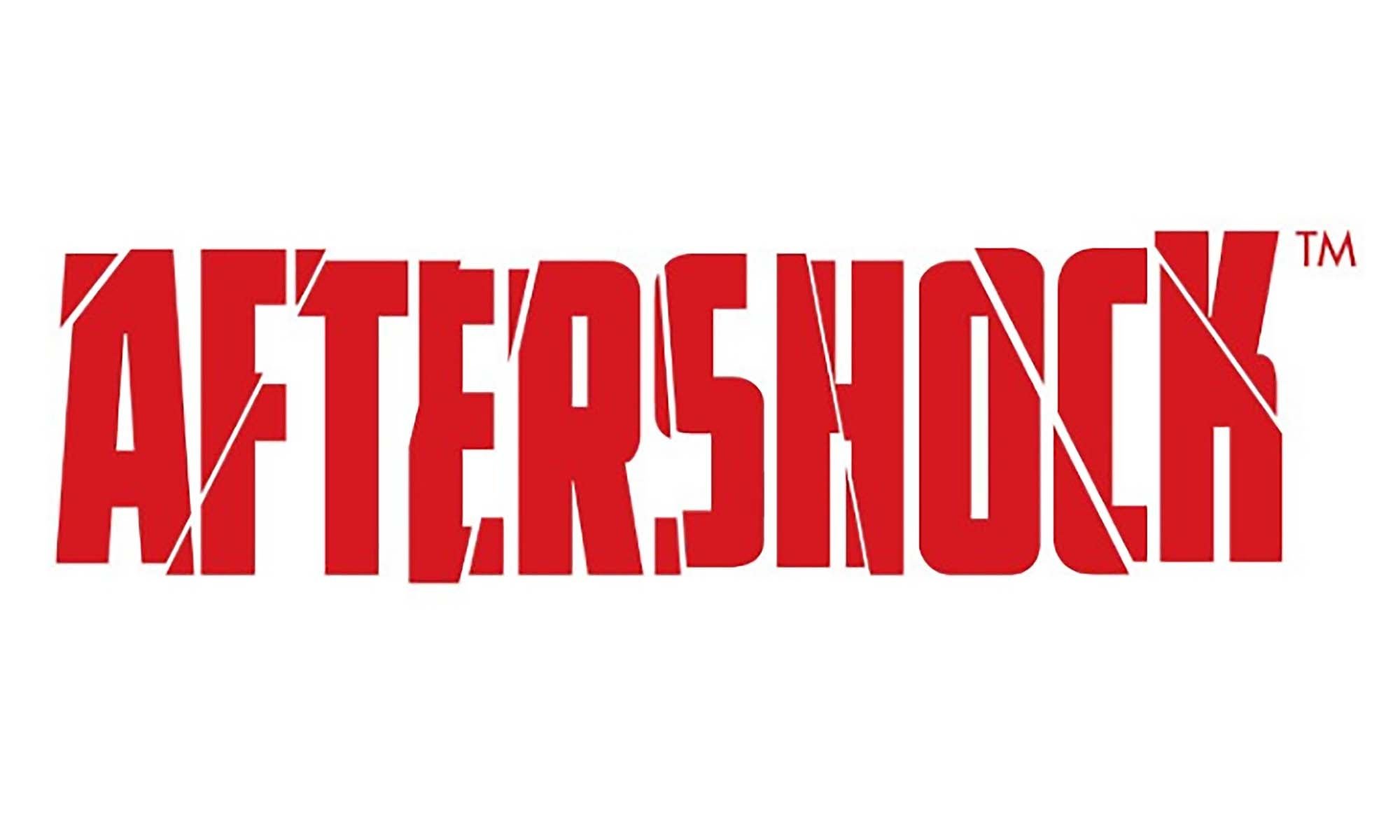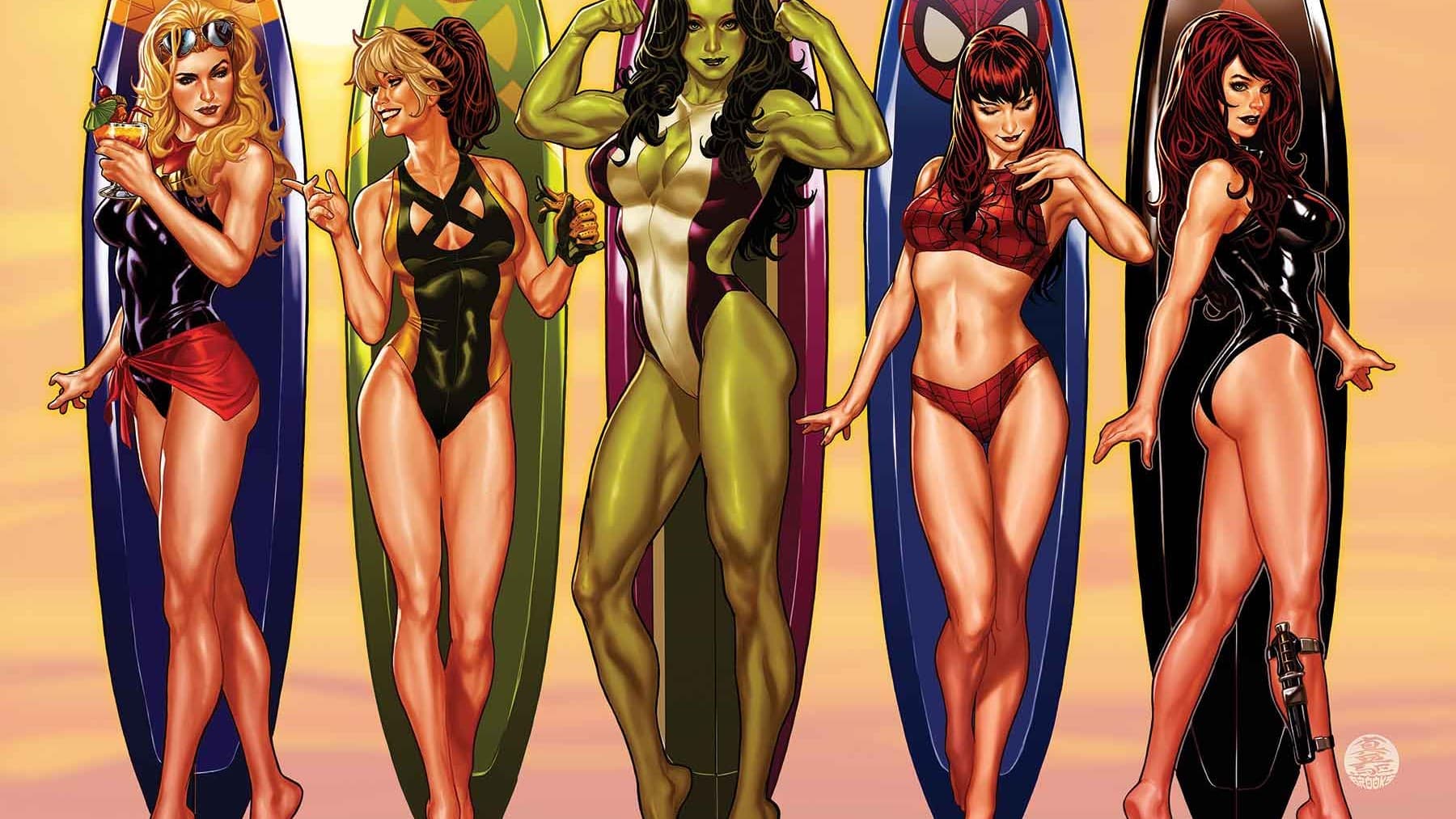We’re all acutely aware of the rise of Marvel as a brand over the past dozen years, powered by the success of the Marvel Cinematic Universe and the company’s acquisition by Disney. However, growing in parallel with the superhero film industry has been the hobby board game one. With over 4000 games published in 2019, hobby board gaming has never been bigger. Unsurprisingly, game publishers haven’t hesitated to release a plethora of Marvel-themed board games. Whether you’re a Marvel reader interested in dabbling in a hobby game or a seasoned board game player looking to find the best Marvel board game, today we’ll be providing an overview of the hottest Marvel game in 2020: Fantasy Flight Games’ Marvel Champions Living Card Game.™
What is Marvel Champions?
Marvel Champions is a co-operative living card game™ produced by Fantasy Flight Games. In it, one to four players use a pre-built, custom deck of cards representing a classic Marvel hero to do battle against a separate deck representing an evil villain and their nefarious scheme.
What is a co-operative card game?
In a game like Magic: The Gathering two players are playing the game against each other. What makes a co-operative card game different is that while each player is still bringing their own deck to the game, their opponents aren’t each other. Instead, you’ll be playing your deck against the game itself. In Marvel Champions, that’s a separate deck of cards for different villains like Ultron or the Green Goblin. You can think of them like different videogame levels you can play, with the villain as the boss of that level you have to defeat.
What is a living card game?
Living card games are a line of card games produced by Fantasy Flight. In a living card game, players have the opportunity to build their own deck of cards to bring to each game of Marvel Champions, similar to Magic: The Gathering or Pokémon cards, but instead of buying new cards from random booster packs, living card games are sold in non-random sets and there is no rarity or any kind of chase/gambling element to buying the game. For example, every Ms. Marvel Hero Pack has the exact same 60 cards in it. That being said, you can still mix and match the cards between all your Marvel Champions purchases just like any other customizable card game!
So how does it work?
Each player is playing a hero and has a corresponding double-sided hero “identity card” and a hero deck of 40 to 50 cards of their choosing. They will be playing against the chosen villain deck and its matching scenario. Each game of Marvel Champions is broken down into a series of rounds that comprises two phases: a villain phase and then a hero phase. Over those rounds, the villain will be accumulating threat points and if they accumulate a certain amount, dictated by the scenario, the players lose. The players, then, are trying to deal damage to the villain as a team before they can complete their scheme to win!
(If you want a full overview of the rules, you can find the Learn to Play guide on Fantasy Flight Games’ website here or watch a tutorial video like this one from Team Covenant. However, I’ll provide a streamlined overview below.)
Villain Turn
During the villain phase, the villain will perform three steps:
1. The villain’s scheme will advance.
The villain’s scheme is their objective. Rhino is trying to steal weapons and other technology from a SHIELD facility. Ultron, however, is trying to infiltrate NORAD and unleash a nuclear apocalypse. During this step, threat counters are placed on the scheme. If the threat on a scheme ever reaches its maximum then the scheme advances to the next stage. If the final stage is reached, the players lose the game!
2. The villain activates.

Next, the villain themselves will either attack a hero or further their scheme. For each player, the villain will act depending on their mode. If a player is in hero mode, the villain will attack them. If a player is in their alter-ego mode, then the villain will scheme. When a character is attacked, they can choose to block, have an ally block, or take the damage undefended. If your character takes damage equal to your character’s life, you’re eliminated from the game; if all players’ main character is eliminated, then the game is over!
3. Players draw treachery cards.

Once the villain has activated once per player, then each player draws one card from the villain deck as a treachery card and in turn order resolves its effect. Treachery cards can be foul events (Ultron could spawn more drones), minions (Shocker could join the fray to aid Rhino in his robbery), or even additional schemes the player must deal with (Klaw has entered his sound form). Regardless of their type, treacheries are always bad and contribute to the challenges the heroes will face on their new turn.
Hero Turn
On the hero turn, each hero player will take one turn, in player order. On their turn a player can do any of the following in any order:
1. Flip their character card.

Each character card in the game is double-sided. Players begin the game in their Alter-Ego mode but can, once per turn, flip to the other side. Certain actions will require a character to be in their Hero or Alter-Ego mode to use — She-Hulk, for example, has a number of cards around her law practice that require her to be on her Jennifer Walters side.
2. Activate their characters.
Like villains, characters can activate. When you activate a character, you “exhaust” it — turning it sideways, akin to tapping a card in Magic, signifying it has been used this turn. When heroes activate, they can perform a “thwart” activation to remove threat from a scheme, an “attack” to do damage to the villain, or — if in alter-ego — a “recover” to heal damage. Heroes also exhaust to defend, so if a hero blocks an attack in the villain turn, they won’t be able to do one of these activations on the hero turn. Allies also activate, but only to thwart or attack.
3. Play more cards!

Heroes alone can’t save the day. To that end, they’ll need to play cards from their hand to help, whether allies, equipment, or simply to leverage their own super powers.
There are four types of cards in a player’s deck: (1) allies are other superheroes who will joy the fray; (2) equipment and (3) supports range from Iron Man’s ARC reactor to the Helicarrier to Aunt May baking Peter Parker a pie; (4) event cards are one-off actions you play from your hand — things like a photon blast or tingling Spider-Sense. Each turn, a player starts with a full hand of cards and has to decide which to play and which to spend as resources. To play a card, a player has to discard cards from their hand with a total number of resource icons equal to that card’s cost.

For example, to play a Swinging Web Kick that costs three resources, a player must discard three resource icons worth of cards — in this example, they might choose to discard Genius, which generates 2 resources, and a Spider-Tracer, which generates one, to generate three total resources.
And so on…
Once all players have gone, if the villain is not defeated, each player will ready all their cards (turn them vertically, so they are no longer exhausted and thus ready for a new round) and draw a new hand of cards. Play will then continue with the villain phase and whatever new threats it will bring!
So how is it?
At the beginning of this overview, I claimed that Marvel Champions was the hottest Marvel board game of 2020. What’s led to its success in the past six months?
1. The game’s thematic. Spider-Man clobbers Rhino with a Swinging Web Kick before heading home to rest up with one of Aunt May’s pies. Nick Fury appears to provide She-Hulk with the resources she needs from SHIELD to ground stomp an entire horde of Ultron’s Drone minions. These are just the kind of classic comic book moments you can recreate in Marvel Champions that you’re looking for as a Marvel fan. Each character feels unique and each villain brings their own flavor to the battle, but the designers have done well to root much of the game in the source material. Like any hobby card game, there is a degree of abstraction, but they are artfully strung together to create moments like when Spider-Man will use his Spider-Sense power to draw a card during a Rhino charge, draw a Backflip card, and play it to avoid all the damage from Rhino that leap right off the page onto your table.
2. The game’s replayable. The Core Set of the game contains five heroes to play, three different villain scenarios, and has two different difficulty modes. This doesn’t even factor any of the deck building you can do, meaning that there are tons of combinations to mix and match. On top of that, with new content every month Marvel Champions constantly gives players reasons to revisit the game. It’s not one you will play three or four times and never have a reason to revisit, rather it’s a lifestyle game you can bring to the table often with fresh new experiences. On top of that, the game can be played solo, which is a slightly different experience than multiplayer, giving it another layer of unique, alternative gameplay.
3. The game’s fun. At the end of the day, though, this is a game and the real barometer is if it’s actually, you know, fun. And I can safely say that Marvel Champions is a good time. One thing I particularly like is how the core resource mechanic encourages you to play most of the cards in your hand each turn, so no two turns will ever be exactly alike. In some games, you can get stuck with a shortage of resources or have simply already played many of your key cards, and your turn can devolve into simply performing the same one or two actions perpetually. That’s not the case in Marvel Champions. It also does a good job of allowing players to assume the role of their hero. Other games give you control of a team of heroes, but few have captured the feeling of coming to the table as Captain Marvel or Black Panther as well as Marvel Champions does. The player count flexibility, too, means that you’re not hampered by needing only two players or needing three or more. This is the one Marvel game you need.
So who might it not be for? No board game is for everyone! Despite its comparative accessibility, it’s still a fairly complicated game. There are a lot of rules and corner cases you’ll need addressed. For players who are used to these challenges from other customizable card games, this is nothing unusual, but if you’re not particularly familiar with hobby games, it can be a steeper learning curve to pick up both the game and all the cards in it. This also means that the audience for the game skews a bit older than some Marvel board games, with the recommended age listed at 12 up. I’d say that with parent help kids 10 and up could easily get the hang of it.
It’s also a game that can run a bit long, particularly if players are unfamiliar with card games or struggle with “analysis paralysis.” This is mostly a concern at higher player counts. The game tends to run twenty to thirty minutes per player, so a four player game can run over two hours if the players are slower. Some will find the game overstaying its welcome at that runtime, so it’s considered best with two or three players at 60 to 90 minutes.
How do I get the game?
Marvel Champions is available online or from your friendly local gaming store! The game has a number of products, but everyone will want to start in the same place: the Marvel Champions Core Set. This is a box that features everything one to four players need to play and includes Spider-Man, Iron Man, Captain Marvel, Black Panther, and She-Hulk, as well as villainous schemes for Rhino, Klaw, and Ultron for $59.99.
What are all these other products?
Once you’ve had your fun with the Core Set, future products come in three varieties:

Hero packs introduce new heroes to the game, like Captain America and Ms. Marvel, and feature a ready-to-play deck when you open the box. They also include some additional, bonus cards for other decks. They retail for $14.99.

Scenario packs add new, standalone villain scenarios to the game, featuring the nefarious schemes of the likes of Green Goblin or the Wrecking Crew. They retail for $17.99.
At the time of this article, no campaign boxes have been released. The first, still untitled campaign box will release July 2020. Though no specifics have been announced, Fantasy Flight have confirmed the campaign boxes will be larger expansions with 2 to 3 heroes and 3 to 4 villains or scenarios that all loosely tie together with a theme.
With all that said, any comic fans with any inkling towards bringing a co-operative card game to their table should take a long look at Marvel Champions. It’s been a major success so far, and as more content comes out over the course of 2020 the game will only continue to get better. All we need now is the promised eventual arrival of the X-Men for the game to be the perfect Marvel game for this reviewer.
This comes to us from the gamesmaster Cory Bullock
Zachary Jenkins co-hosts the podcast Battle of the Atom and is the former editor-in-chief of ComicsXF. Shocking everyone, he has a full and vibrant life outside all this.






